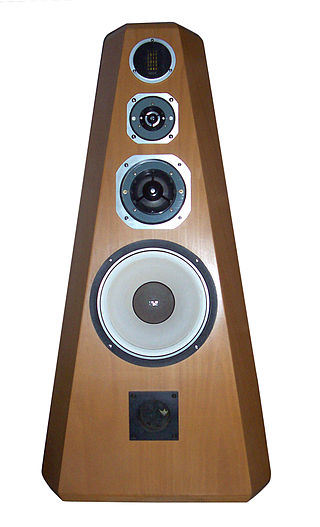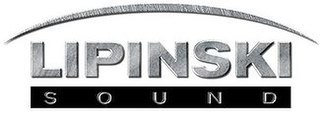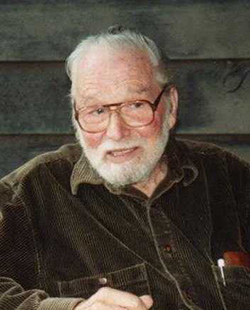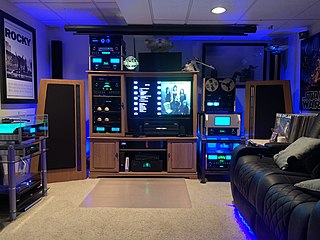
High fidelity is the high-quality reproduction of sound. It is popular with audiophiles and home audio enthusiasts. Ideally, high-fidelity equipment has inaudible noise and distortion, and a flat frequency response within the human hearing range.

A loudspeaker is an electroacoustic transducer that converts an electrical audio signal into a corresponding sound. A speaker system, also often simply referred to as a speaker or loudspeaker, comprises one or more such speaker drivers, an enclosure, and electrical connections possibly including a crossover network. The speaker driver can be viewed as a linear motor attached to a diaphragm which couples that motor's movement to motion of air, that is, sound. An audio signal, typically from a microphone, recording, or radio broadcast, is amplified electronically to a power level capable of driving that motor in order to reproduce the sound corresponding to the original unamplified electronic signal. This is thus the opposite function to the microphone; indeed the dynamic speaker driver, by far the most common type, is a linear motor in the same basic configuration as the dynamic microphone which uses such a motor in reverse, as a generator.
An audiophile is a person who is enthusiastic about high-fidelity sound reproduction. An audiophile seeks to reproduce recorded music to achieve high sound quality, typically in a quiet listening space and in a room with good acoustics.
A cassette deck is a type of tape machine for playing and recording audio cassettes that does not have a built-in power amplifier or speakers, and serves primarily as a transport. It can be a part of an automotive entertainment system, a part of a portable mini system or a part of a home component system. In the latter case it is also called a component cassette deck or just a component deck.

Dolby Laboratories, Inc. is a British-American technology corporation specializing in audio noise reduction, audio encoding/compression, spatial audio, and HDR imaging. Dolby licenses its technologies to consumer electronics manufacturers.

KLH Audio is an American audio electronics company based in Noblesville, Indiana. Originally founded in 1957 as KLH Research and Development Corporation in Cambridge, Massachusetts, the company takes its name from the initials of its founders: Henry Kloss, Malcolm S. Low, and Josef Anton Hofmann.

Rudolph Thomas Bozak (1910–1982) was an audio electronics and acoustics designer and engineer in the field of sound reproduction. His parents were Bohemian Czech immigrants; Rudy was born in Uniontown, Pennsylvania. Bozak studied at Milwaukee School of Engineering; in 1981, the school awarded him an honorary doctorate in engineering. Bozak married Lillian Gilleski; the two had three daughters: Lillian, Mary and Barbara.

Cambridge SoundWorks was a Massachusetts-based consumer audio manufacturer and retailer.

Acoustic Research was a Cambridge, Massachusetts-based company that manufactured high-end audio equipment. The brand is now owned by VOXX. Acoustic Research was known for the AR-3 series of speaker systems, which used the 12 in (300 mm) acoustic suspension woofer of the AR-1 with newly designed dome mid-range speaker and high-frequency drivers. AR's line of acoustic suspension speakers were the first loudspeakers with relatively flat response, extended bass, wide dispersion, small size, and reasonable cost. The AR Turntable remains a highly sought vinyl record player.
The history of sound recording - which has progressed in waves, driven by the invention and commercial introduction of new technologies — can be roughly divided into four main periods:

Advent Corporation was a consumer audio and video hardware company founded in Cambridge, Massachusetts by Henry Kloss in 1967. It closed in 1981.

Acoustic suspension is a loudspeaker cabinet design that uses one or more loudspeaker drivers mounted in a sealed box. Acoustic suspension systems reduce bass distortion which can be caused by stiff suspensions required on drivers used for open cabinet designs.
Dr Harry Ferdinand Olson, E.E., Ph.D. was a prominent engineer and inventor with RCA Victor, the Acoustic Research Director of RCA Laboratories, Princeton, and a pioneer in the field of 20th century acoustical engineering notably in the fields of high-fidelity, digital music synthesis, microphones, loudspeakers, acoustics, radar, submarine communication, magnetic tape and noise reduction.

Lipinski Sound is a professional market and audiophile oriented manufacturer of loudspeakers, subwoofers, powered speaker stands, surround sound systems, power amplifiers, microphones, and microphone preamplifiers.
Tivoli Audio is an American manufacturing company that produces up-market tabletop radios and related audio products. It was founded in 2000 by Tom DeVesto in collaboration with Henry Kloss.
A bookshelf loudspeaker is a compact loudspeaker, generally sold for consumer-grade home audio applications as part of a shelf stereo pair or home theater package, that is compact in size and intended to be placed on a raised surface, e.g. a bookshelf.

Edgar Marion Villchur was an American inventor, educator, and writer widely known for his 1954 invention of the acoustic suspension loudspeaker which revolutionized the field of high-fidelity equipment. A speaker Villchur developed, the AR-3, is exhibited at The Smithsonian Institution's Information Age Exhibit in Washington, DC.

Home audio refer to audio consumer electronics designed for home entertainment, such as integrated systems like shelf stereos, as well as individual components like loudspeakers and surround sound receivers.

Josef Anton Hofmann was a London-born American audio engineer and speaker-system designer. He is known for Hofmann's Iron Law, and was a son of pianist Josef Hofmann.
Spendor is a British loudspeaker manufacturing company founded in 1969 by audio engineer Spencer Hughes (1924–1983) and his wife Dorothy. It is located in East Sussex. The name was derived from the first names of both.
















